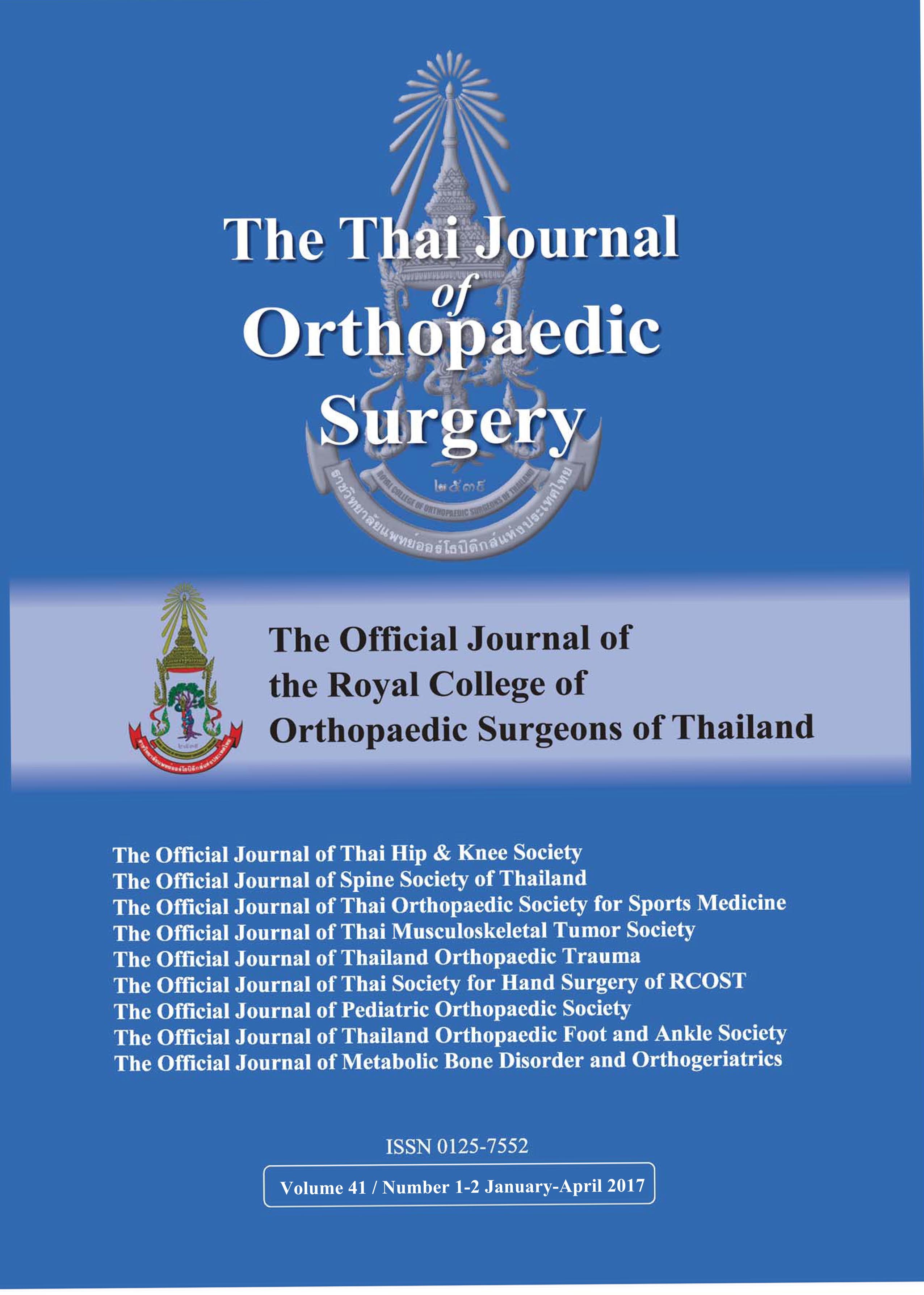Effect of Bone Plugging at the Distal Femoral Drilled Hole in Total Knee Arthroplasty on Early Clinical Outcomes
Main Article Content
Abstract
Purpose: Bone plugging at the intramedullary (IM) femoral drilled hole in total knee arthroplasty (TKA) is performed with expectation to decrease blood loss. We hypothesized that the retained blood in IM canal may affect postoperative thigh & leg heaviness (TLH), quadriceps peak torque (QPT) and immediate clinical outcomes.
Methods: Eighty-one patients undergoing unilateral TKA using IM femoral bone cut were randomly divided into 2 groups; group I: drilled hole plugged with a bone graft, and group II: drilled hole was left open. Postoperatively, clinical parameters were sequentially evaluated until 12 weeks.
Results: There were 41 knees in group I and 40 knees in group II. Preoperative demographic data of both groups were not different. There was no difference in blood collected from drain and transfusion rate. The TLH similarly changed from severe grade at 2 weeks to none and mild grade at 12 weeks. The QPT was similarly decreased by 38% at 2 weeks, and improved to preoperative level at 12 weeks. There were no differences in visual analog scale (VAS), range of motion (ROM), Western Ontario and McMaster Universities Arthritis Index (WOMAC) and Knee Society System (KSS) scores between both groups.
Conclusion: Comparing between plugging or unplugging femoral IM hole in TKA, the present study found no difference in blood loss, and retained blood in IM canal did not have effect on TLH, QPT and other immediate clinical outcomes. Plugging of the femoral IM hole provided no harm or advantages which could be performed according to surgeon’s preference.
Article Details
References
2. Tanavalee A, Thiengwittayaporn S, Ngarmukos S. Rapid ambulation and range of motion after minimally invasive total knee arthroplasty. J Med Assoc Thai 2004; 87 Suppl 2: S195-201.
3. Costa CR, Johnson AJ, Harwin SF, Mont MA, Bonutti PM. Critical review of minimally invasive approaches in knee arthroplasty. J Knee Surg 2013; 26: 41-50.
4. Nophakhun P, Yindee A, Amornpiyakij P, Hlekmon N, Tanavalee A. The efficiency of the patient care team on 3-day protocol for early ambulation after MIS-TKA. J Med Assoc Thai
1. 2012; 95: 537-43.
5. Berth A, Urbach D, Awiszus F. Improvement of voluntary quadriceps muscle activation after total knee arthroplasty. Arch Phys Med Rehabil 2002; 83: 1432-6.
6. Mizner RL, Petterson SC, Stevens JE, Vandenborne K, Snyder-Mackler L. Early quadriceps strength loss after total knee arthroplasty. The contributions of muscle atrophy and failure of voluntary muscle activation. J Bone Joint Surg Am 2005; 87: 1047-53.
7. Raut VV, Stone MH, Wroblewski BM. Reduction of postoperative blood loss after press-fit condylar knee arthroplasty with use of a femoral intramedullary plug. J Bone Joint Surg Am 1993; 75: 1356-7.
8. Kumar N, Saleh J, Gardiner E, Devadoss VG, Howell FR. Plugging the intramedullary canal of the femur in total knee arthroplasty: reduction in postoperative blood loss. J Arthroplasty 2000; 15: 947-9.
9. Ko PS, Tio MK, Tang YK, Tsang WL, Lam JJ. Sealing the intramedullary femoral canal with autologous bone plug in total knee arthroplasty. J Arthroplasty 2003; 18: 6-9.
10. Protzman NM, Buck NJ, Weiss CB. Autologous bone plugs in unilateral total knee arthroplasty. Indian J Orthop 2013; 47: 182-7.
11. Reinking MF, Bockrath-Pugliese K, Worrell T, Kegerreis RL, Miller-Sayers K, Farr J. Assessment of quadriceps muscle performance by hand-held, isometric, and isokinetic dynamometry in patients with knee dysfunction. J Orthop Sports Phys Ther 1996; 24: 154-9.
12. Bellamy N, Buchanan WW, Goldsmith CH, Campbell J, Stitt LW. Validation study of WOMAC: a health status instrument for measuring clinically important patient relevant outcomes to antirheumatic drug therapy in patients with osteoarthritis of the hip or knee. J Rheumatol 1988; 15: 1833-40.
13. Insall JN, Dorr LD, Scott RD, Scott WN. Rationale of the Knee Society clinical rating system. Clin Orthop Relat Res 1989; (248): 13-4.
14. Klein MP, Rahn BA, Frigg R, Kessler S, Perren SM. Reaming versus non-reaming in medullary nailing: interference with cortical circulation of the canine tibia. Arch Orthop Trauma Surg 1990; 109: 314-6.
15. Stevens-Lapsley JE, Balter JE, Kohrt WM, Eckhoff DG. Quadriceps and hamstrings muscle dysfunction after total knee arthroplasty. Clin Orthop Relat Res 2010; 468: 2460-8.
16. Conway JD, Shabtai L, Specht SC, Herzenberg JE. Sequential harvesting of bone graft from the intramedullary canal of the femur. Orthopedics 2014; 37: e796-803.

